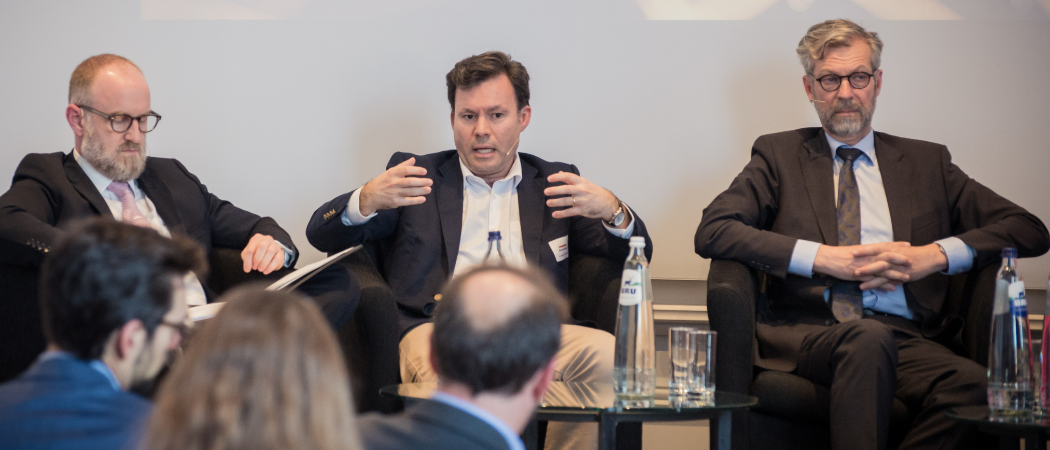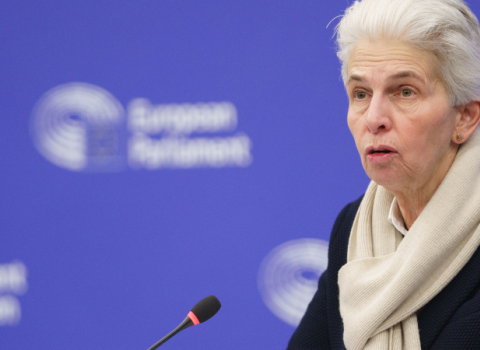As well as supporting dual-use projects in Horizon Europe, more links will be sought with programmes such as the European Defence Fund

From left to right: Ethan Corbin, director of the defence and security committee of the NATO Parliamentary Assembly, Manuel Aleixo, a member of research commissioner Ekaterina Zaharieva’s office, and Robert de Groot, vice-president of the European Investment Bank. Photo credits: Jeroen Vanhecke
The European Commission wants to make it easier for research and innovation projects to move between civilian and military programmes, a Science|Business event on security and defence heard on June 12.
“We should not just look at dual use within the civilian research programme, we should look into how the civilian and the European defence research programmes should interact better,” Manuel Aleixo, a member of research commissioner Ekaterina Zaharieva’s office, told the conference.
He gave the example of better mechanisms for spinning civilian developments in and out of military research, and vice versa. The suggestion comes as the Commission prepares to present its proposal for a revamp of EU funding instruments in July.
The EU currently supports defence research and development projects through the €7.3 billion European Defence Fund (EDF), which launched in 2021. Under the EU Defence Innovation Scheme, SMEs already have access to EDF spin-in calls to bring their results from civil EU-funded R&D programmes to the defence sector, but more is needed, Aleixo said.
EDF grants primarily support collaborative projects with multiple participants from different countries. However, in its start-up and scale-up strategy, published last month, the Commission revealed plans to develop new instruments to invest in security and defence companies, potentially including targeted support to single entities as well as equity and debt instruments.
According to Aleixo, there should be more support for civilian start-ups that could have defence applications, but the hope is that more cross-fertilisation will also benefit civilian domains. “Historically, [in the US], the trickle down of technology was precisely from defence research to civilian applications,” he said. “We have to learn how to do that, [but] not exactly as it was done in the US because this is a completely different reality.”
Verena Fennemann, head of the Fraunhofer research organisation’s EU office, told the conference that this may not be straightforward. There are opportunities to create synergies between civil and military research programmes, but they have very different processes to which applicants must adapt.
“We cannot bring them easily together,” she said. “If you do EDF projects, you need clearances, you need security standards, you need to talk to your ministry.” Fraunhofer has been working on both civilian and military research for decades, but for other institutions, embracing dual use could require a change in mindset and more understanding of the conditions defence projects must fulfil.
One of the first tasks will be to define which technologies and technology readiness levels to target, as there may be more dual-use potential at earlier stages of development, for example. Defining security levels and whether there should be more restrictions for associated countries will also need to be considered, Fennemann said.
Ethan Corbin, director of the defence and security committee of the NATO Parliamentary Assembly, identified several barriers to defence innovation in Europe, including a lack of investment and a fragmented market. However, perhaps the biggest difference with the US is that many Europeans are still reticent about embracing dual use, he said.
In the US, “they view AI and they view space, et cetera, as something for strategic great power competition, and Europeans still view it for research and academic purposes, and to a degree commercial, but not as much,” Corbin said.
Dual use in Horizon Europe
The Commission recently proposed introducing an exemption to Horizon Europe’s exclusively civilian focus to allow the European Innovation Council Accelerator programme to support dual-use technologies. This idea is now being examined by the European Parliament and the Council.
Other parts of the programme could potentially be opened up to dual-use projects in its next iteration, starting in 2028, but the content and scope of the Framework Programme must depend on its level of funding, Aleixo said.
“I don’t think we can conceptualise a research funding programme and then cut the budget to size,” he said. “If you have a budget of €50 billion, you can have a certain type of programme, if you have a budget of €100 billion you can have another type of programme, and if you have €200 billion you have a different approach.”
Related articles
- Commission wants Horizon Europe to fund dual-use technologies
- European Investment Bank under pressure to increase defence funding
For Aleixo, it is “beyond dispute” that the EU should continue investing in fundamental research through instruments such as the European Research Council and Marie Skłodowska-Curie Actions, but support for collaborative research, innovation and scaling up will all depend on the level of funding member states agree to commit.
“That for me is the question at the moment: what will be our level of ambition for the Framework Programme, and how that will shape the choice of instruments and the toolbox we will have at our disposal?” he said.
No more dual use
The European Investment Bank (EIB) has also expanded its mandate to invest in security and defence companies, at the request of member states, focusing on four areas: infrastructure; research, development and innovation; SMEs; and manufacturing.
The EIB no longer refers to dual use but to security and defence investments, which cover everything except weapons and ammunition, EIB vice-president Robert de Groot explained.
In 2022, the bank launched its Strategic European Security Initiative to provide €6 billion for dual-use research and innovation projects, which later rose to €8 billion. However, in March it announced this initiative would be integrated into a permanent public policy goal. This means the €8 billion cap has been scrapped, and funding in the sector will now be determined annually.
De Groot cited space, AI, data centres and the protection of civil infrastructure such as hospitals or energy networks as areas where the EIB needs to be more active in the coming years.





 A unique international forum for public research organisations and companies to connect their external engagement with strategic interests around their R&D system.
A unique international forum for public research organisations and companies to connect their external engagement with strategic interests around their R&D system.